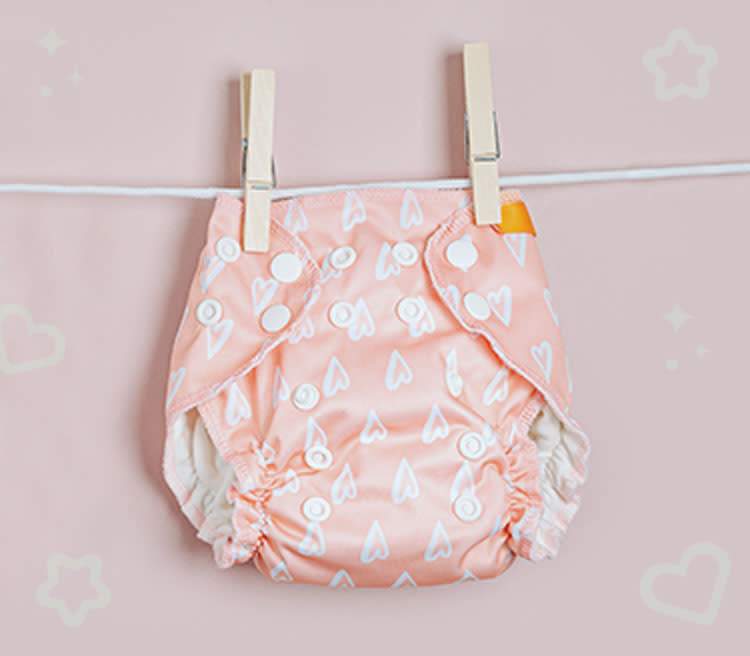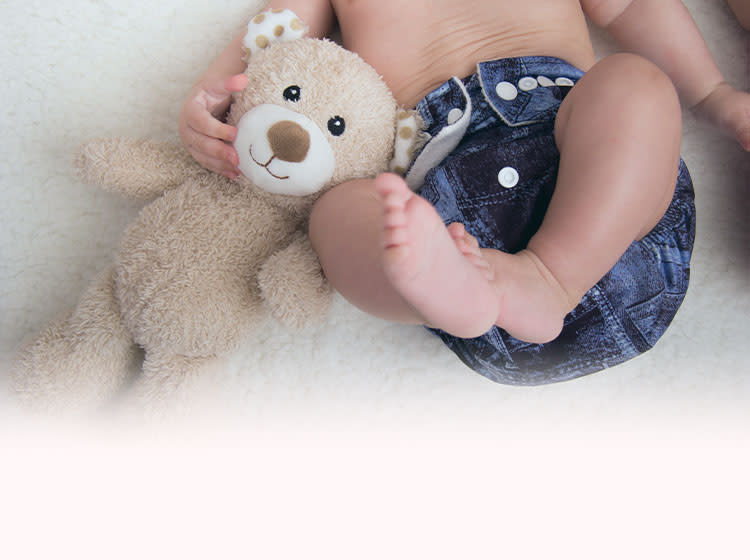Types of Cloth Diapers
If you’re still in the “selection” phase, here’s a quick primer on different types of cloth diapers you can buy or add to your baby registry.
Prefolded cloth diapers
These are the classics; the cloth diapers our grandmothers used. Prefolds are basically big, multi-layered pieces of absorbent cloth, deftly wrapped around a baby. In olden days, they were secured with simple safety pins, but here in the future you’ll probably want to add a waterproof cover. These are, by far, the cheapest cloth diapers you can find.
All-in-one cloth diapers
These cloth diapers are easy as can be—simply picture a disposable diaper but made of cloth! Most all-in-ones have multiple sets of snaps so they can grow with your baby. Their one drawback is that they can take longer to dry after washing, so you may need to have a larger stash on hand to make sure your needs are met.
Pocket cloth diapers
Pockets are some of the most popular cloth diapers because of their flexibility. They consist of a waterproof liner with a pocket where an absorbent pad (or two, if necessary) can be stuffed. The liners dry quickly after washing, and the pads are relatively inexpensive. Like all-in-ones, the liners usually have multiple sets of snaps for multiple baby booty sizes. They’re a little more work than all-in-ones, but their popularity means you can likely find a deal on the secondhand market.
Hybrid cloth diapers
These cloth diapers, sometimes called “all-in-two” diapers, offer a compromise between reusable diapers and disposable diapers: a reusable waterproof liner with a spot to place either a reusable liner or a disposable (but often biodegradable) liner.
Advantages of Using Cloth Diapers
Some of the advantages of using reusable diapers instead of disposables are obvious—namely, a smaller impact on the planet. Another reason why parents might choose cloth diapers is to save money, although this approach does require a larger initial investment. But it also means if you’re planning for more than one child, congrats—you’ve found one of the only situations where having a bigger family will actually increase your savings.
Beyond the obvious advantages, cloth diapers also come with other, lesser-known benefits should consider. For instance, did you know that babies who use cloth diapers are often earlier to potty train? Or that some babies have allergic reactions to the chemicals in disposable diapers, making cloth diapers the best option for their delicate skin?
Cloth diapers are a solid choice for your baby, your wallet, and the planet. But how do you clean cloth diapers, and how complicated is the cleaning process? With your home washing machine, a couple of easily found cloth diaper laundry accessories, and a gentle and safe cloth diaper detergent in Dreft, your cloth—diaper-washing routine can be as easy as 1-2-3.
How to Clean Reusable Diapers
Step 1. Prepare cloth diaper for washing
The main way in which cleaning cloth diapers differs from other loads of laundry (even baby clothes) is in what happens pre-washing-machine. The fact is, unless your baby is exclusively fed with breastmilk (which results in waste that’s water-soluble), you must get the poop out of those diapers before they go into the wash.
If the waste is solid enough, you can simply tip it from the diaper into the toilet … but let’s be real, baby poop is rarely solid enough to do that, so you have two choices. The easiest and most cost-effective way is to stick the diaper into the toilet and swish until the diaper is poop-free. Your other option (the not-ever-up-for-touching-dirty-toilet-water option) is to purchase a diaper sprayer. These can be hooked up to your toilet and used to spray the waste off your cloth diapers.
When your dirty diaper is free of all poop except for perhaps some lingering stains (or if it was just a wet diaper to begin with), it goes into a diaper pail or waterproof wet/dry bag until it’s time to do laundry.
Step 2. When it’s time to wash a load of cloth diapers
How often should you wash your cloth diapers? Plan to do a load every day or every other day at minimum. If you let your wet diapers sit any longer than that, they run the risk of developing mildew, which can mean staining and extra washing. Make sure not to wash more than 12 to 18 diapers per load.
Once you get the diapers into the washer, the hard work of how to clean reusable diapers is pretty much over—you can let the wonders of modern labor-saving appliances and the power of specially formulated laundry detergent for babies take over. However, you will want to plan for a bit more than the standard washing cycle.
Begin with a cold rinse cycle with no detergent—this will help prevent staining. Then set the hottest wash cycle you can. Use plenty of Dreft detergent on this cycle—it’s the #1 pediatrician-recommended choice and sure to be gentle on your baby’s skin.
And if your washing machine allows you to program an extra rinse at the end, go for it—the more water running through your cloth diapers, the cleaner and less likely to stain they’ll be. From time to time, you might be tempted to wipe out stubborn stains on cloth diapers with bleach, vinegar, or other additives. These chemicals can be harsh on fabrics and on baby’s skin. Stick with gentle, pediatrician-recommended Dreft as your cloth-diaper detergent of choice.
Step 3. Air or line dry the cloth diapers
If you’ve ever heard the saying that sunlight is the best disinfectant, this is one case where that’s definitely true! The best way to dry cloth diapers after washing is to hang them out on a clothesline in the sun.
If that’s not possible, then hang them to dry on a line or a drying rack indoors.
(If you can help it, don’t tumble-dry your cloth diapers because this can degrade the diaper’s waterproofing.)

Additional Tips
There are a few other tips that will make your cloth-diaper experience stellar. For one, you may want to ease yourself into that cloth diaper life by starting small. Try purchasing only a few cloth diapers and having your kiddo wear 2 to 3 every day. If it works out for you, add more cloth diapers to your routine as time and budget allow. Another pro tip for the cloth-diapering set is to make sure you’re never without a waterproof bag to stash a cloth diaper after a quick change. Be sure to stash such a vessel in your diaper bag when you’re out and about, because as great as Target is for parents, they’d probably have something to say about you ripping open a box of Ziplocs in their aisles to use as an emergency wet/dry bag.
Frequently asked questions about washing cloth diapers
With a bit of practice (and Dreft detergent, of course!) you’ll be well on your way to becoming a pro at cleaning cloth diapers.

